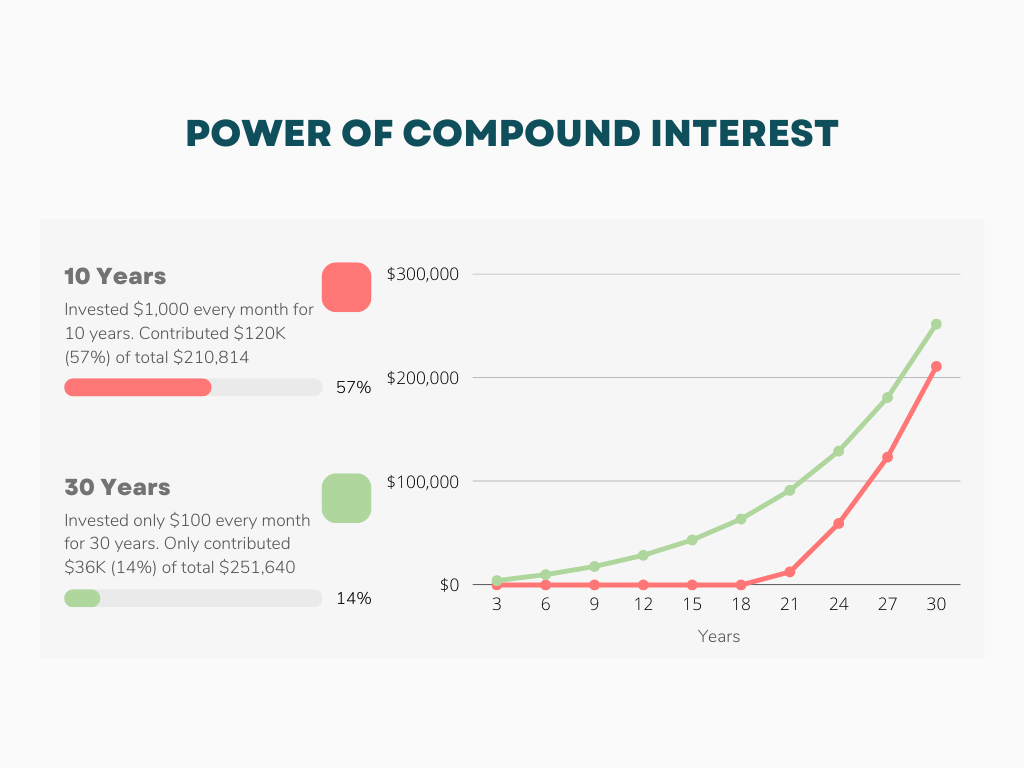Our greatest ally when it comes to creating wealth and growing our net worth is time. As the saying goes people tend to overestimate what they can accomplish in a year and underestimate what they can accomplish in 10 years. The same is true when it comes to investing and growing money. People tend to get discouraged after a year when they see very few if any gains in interest.
The great thing about investing is you don’t need to be some financial savant or have some insider knowledge or secrets. You don’t have to spend hours each day staying on top of which companies are doing well and which ones are failing. In the United States there are index funds which hold a group of companies that allow you to invest into them gaining exposure to many companies and different industries all while also being diversified and not having to do your own individual stock picks. Every index fund has their own criteria of what it takes to be in their index fund and what disqualifies a company. While we are not going to dive into the specifics of any one index fund we will discuss the S&P (Standard and Poor’s) 500 index.
There are many index funds based on the popular S&P 500 index. This index dates back to 1957 and is a market-capitalization-weighted index. It tracks the largest companies in the U.S. based on market capitalization. Since inception in 1957 this index has averaged around 10.5% . That is quite the track record if you ask me. If you were to dig into the returns of each year over that time period then you would quickly see not every year did it have gains, but the years it did lose money are overwhelmingly shadowed by the gains of the good years.
I would like to take a slight detour before continuing on. One thing that confuses a lot of people who aren’t in the financial world or their only exposure to investing is through their companies 401k is when they hear the market or their portfolio lost money. If you invest $X into an S&P 500 index fund, and you hear that the S&P is down the last month, 3 months, year to date, or whatever time frame they are measuring, there is something you need to know. You didn’t lose a dime. If you are investing in the S&P index the only way you could have lost money is if you sold your investments when the market or your portfolio was down.
Now back to the power of compound interest. The rule of 72 is a simple formula we can use to estimate how long it will take to double our money. You simply take 72 and divide it by the expected average annual rate of return. If we refer back to the S&P 500 and its annualized average returns of around 10.5% and apply the rule of 72 to it. We can estimate that it will take us a little less than 7 years to double our money. Now to some that may seem like a lifetime, but 7 years goes quickly and again this is an average. The average annualized returns of the S&P 500 in just the past 10 years have been about 14.5% .
Let’s put this another way to show you how much of an ally time is. We will track 2 individual’s investments with the exact same annual rate of return of 10.5% for both individuals. One individual invested $1,000 a month for 10 years and the other only invested $100 a month for 30 years. We can see that even if we 10x the first individual’s contributions over the entire 10 years they still can’t catch up to the individual investing over 30 years.

At the end of both individuals investing this would be the result. While the person investing only $100 over 30 years beat the other person by about $40,000 one other thing that should jump out at you is that the individual’s contribution over the 30 years was only $36,000. That is only 14% of their total balance! Of their $251,640 balance, $215,640 is from interest. While this is a simple example, hopefully it demonstrates the power of compound interest and the importance of starting your investing journey early.
| Both Individuals Got 10.5% Annual Return | Invested $1,000/month for 10 Years | Invested $100/month for 30 Years |
|---|---|---|
| Contributions | $120,000 (57%) | $36,000 (14%) |
| Interest | $90,814 | $215,640 |
| Total | $210,814 | $251,640 |
This article is not investing advice. You should do your own research before making any investments.





